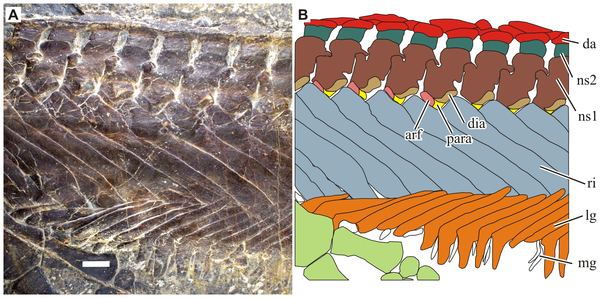Bony body tube for a bizarre marine reptile
Prehistoric marine reptiles were a weird lot, especially in light of their lizard-like ancestors on land. You take something that roughly looks like an iguana, and evolve it into the shape of a dolphin (icthyosaurs), or evolve it into the shape of a turtle (turtles), or stretch out its neck and grow paddles on the limbs (plesiosaurs). That said, as a paleontologist I’ve grown fairly jaded when it comes to marine reptiles. Most of the major groups have been widely known since the dawn of paleontology, so I read all about them as a kid. I knew the story of Mary Anning and her 19th century quest for fossils, and how long-necked elasmosaurs used to swim over what are now the farms, ranches, and prairies of my home state of South Dakota. So, it’s nice to be surprised by a new marine reptile every once in awhile!

Hupehsuchians were a group of marine reptiles that lived around 248 million years ago in Hubei Province, east-central China. It would be an understatement to say that they were bizarre (hence my surprise in learning more about them). Only three genera are known from this fairly tiny geographic region, and none of them exceeded a meter in total body length. They have a long and toothless snout, an elongated body, and flipper-like hands and feet, sometimes with six or seven fingers and toes (a post from microecos back in 2008 provides a helpful summary, as does the Wikipedia page). Addtionally, the first hupehsuchian–Nanchangosaurus–wasn’t named until 1959. Probably owing in part to various geopolitical factors, as well as the fact that they aren’t carnivorous dinosaurs, the group didn’t receive much attention until fairly recently. Their evolutionary relationships are also a little uncertain, with the only consensus being that they are diapsids (the group including lizards, dinosaurs, birds, and most other marine reptiles).

Last week in PLOS ONE, a paper by Xiao-hong Chen, Ryosuke Motani, Long Cheng, Da-yong Jiang, and Olivier Rieppel announced a new and even more bizarre hupehsuchian–the one that takes it all to the next level. Known from a headless skeleton, Parahupehsuchus longus is notable for its truly odd rib cage, which is pretty remarkable given that some hupehsuchians have an odd rib cage from the start.
For most four-limbed animals with ribs, each rib is separated from the next by a little gap. You might be able to feel it on yourself, and you are certainly familiar with it from pictures of human skeletons. These gaps are nice in allowing the flexibility of the rib cage needed for locomotion and breathing. Animals that close these gaps–such as turtles–simultaneously develop new ways of breathing with special internal muscles and have to alter their locomotion, too. It turns out that Parahupehsuchus gets funky with its ribs also, by expanding the leading and trailing edges of each individual rib so that it runs into the adjacent ribs (see picture below).

The result is a “body tube” of bone surrounding all of the squishy, tasty viscera in the torso of Parahupehsuchus. What good is this kind of structure, especially if it makes it hard to breathe conventionally? The authors of the paper hypothesize that the odd rib arrangement was a defense against large predators that were evolving at just about that same time.
This seems intuitively appealing, but I do wonder if an alternative explanation is possible. It is fairly certain that the overlapping ribs of Parahupesuchus stiffened the trunk–but could this be related to locomotion rather than defense? Many aquatic organisms store and release elastic energy within the body for efficient swimming–effectively, treating the body as a spring that is tensed and un-tensed through the movement cycle. All else being equal, an animal with a stiff body stores more elastic energy than one with a “floppy” body during equivalent undulations. As small aquatic animals, perhaps the stiff torsos of Parahupehsuchus and relatives were selected for locomotor efficiency. This is certainly an idea worth investigating…and it doesn’t rule out other functions for the stiff body (including defense).
In any case, hupehsuchians are a fun group of organisms that display some pretty darned unique anatomy. Lots of food for thought, and that’s a good thing! It’s going to take quite a bit of brain power to figure out these odd-balls.

Citation
Chen X-h, Motani R, Cheng L, Jiang D-y, Rieppel O (2014) A carapace-like bony ‘body tube’ in an Early Triassic marine reptile and the onset of marine tetrapod predation. PLoS ONE 9(4): e94396. doi:10.1371/journal.pone.0094396
